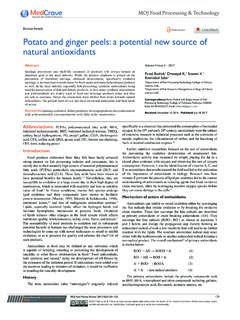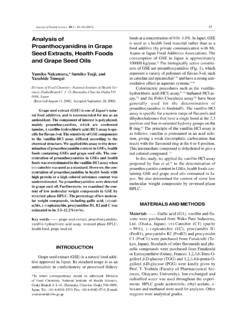Transcription of The British Frozen Food Federation – A Case for …
1 Why?Nutrition is a major issue for cost sector foodservice providers particularly in the case of hospital and school meal provision. Minimal per capita budgets make achieving nutrition targets a key challenge for caterers. Frozen food is a cost effective solution but a common misconception existed that Frozen food is nutritionally inferior to other options. What?In 2009, BFFF commissioned two pieces of research in partnership with the Local Authority Caterers Association and the Hospital Caterers Association to tackle this misconception. Independently conducted by the Centre for Food Innovation at Sheffield Hallam University, the research compared the levels of 37 key nutrients in meals on cost sector menus.
2 Research involved: Scientists compared nutritional content of menus at four UK schools and a rotational menu at one hospital using statistical analysis Independent sample t-tests were carried out to determine differences between the average nutritional value of fresh and Frozen food Results were compared and evaluated to establish the nutritional impact of Frozen . ResultsResearchers concluded: Making a duplicate recipe from scratch cost on average 24% more than using Frozen In the case of canap s and profiteroles, caterers can save up to 66% and 65% respectively It is more cost effective for pubs and restaurants to create dishes from Frozen , because Frozen : Is less labour intensive Has significantly faster cooking times, requiring less energy Generates significantly lower waste and Hospitals Nutrition 2010 The British Frozen Food Federation A Case for Frozen FoodWhy?
3 Nutrition is a major issue for cost sector foodservice providers particularly in the case of hospital and school meal provision. Minimal per capita budgets make achieving nutrition targets a key challenge for caterers. Frozen food is a cost effective solution but a common misconception existed that Frozen food is nutritionally inferior to other options. What?In 2009, BFFF commissioned two pieces of research in partnership with the Local Authority Caterers Association and the Hospital Caterers Association to tackle this misconception. Independently conducted by the Centre for Food Innovation at Sheffield Hallam University, the research compared the levels of 37 key nutrients in meals on cost sector menus.
4 Research involved: Scientists compared nutritional content of menus at four UK schools and a rotational menu at one hospital using statistical analysis Independent sample t-tests were carried out to determine differences between the average nutritional value of fresh and Frozen food Results were compared and evaluated to establish the nutritional impact of Frozen . Why?Nutrition is a major issue for cost sector foodservice providers particularly in the case of hospital and school meal provision. Minimal per capita budgets make achieving nutrition targets a key challenge for caterers. Frozen food is a cost effective solution but a common misconception existed that Frozen food is nutritionally inferior to other options.
5 What?In 2009, BFFF commissioned two pieces of research in partnership with the Local Authority Caterers Association and the Hospital Caterers Association to tackle this misconception. Independently conducted by the Centre for Food Innovation at Sheffield Hallam University, the research compared the levels of 37 key nutrients in meals on cost sector menus. Research involved: Scientists compared nutritional content of menus at four UK schools and a rotational menu at one hospital using statistical analysis Independent sample t-tests were carried out to determine differences between the average nutritional value of fresh and Frozen food Results were compared and evaluated to establish the nutritional impact of Frozen .
6 ResultsResearchers concluded: Making a duplicate recipe from scratch cost on average 24% more than using Frozen In the case of canap s and profiteroles, caterers can save up to 66% and 65% respectively It is more cost effective for pubs and restaurants to create dishes from Frozen , because Frozen : Is less labour intensive Has significantly faster cooking times, requiring less energy Generates significantly lower waste concluded: Making a duplicate recipe from scratch cost on average 24% more than using Frozen In the case of canap s and profiteroles, caterers can save up to 66% and 65% respectively It is more cost effective for pubs and restaurants to create dishes from Frozen , because Frozen .
7 Is less labour intensive Has significantly faster cooking times, requiring less energy Generates significantly lower waste and Hospitals NutritionSchools and Hospitals Nutrition1 Introduction1 Introduction 1 Providing Nutrition Antioxidant Research 2 Schools and Hospitals Nutrition 3 Consumer Nutrition 4 Reducing Cost Consumer Cost Comparison 5 Foodservice Cost Comparison 6 Pub Business Case 7 Sustainability How Green is a Typical Sunday Roast? 8 Demonstrating QualityTaste and Texture Research 9 Events and PublicationsA Food Vision Report 10N-Ice Restaurant 11 Consumer Cost and Waste Research 12 Consumer Preference Research 12 Fresh Facts on Frozen 13 Why Buy Frozen ?
8 13 ContentsWelcome to A Case for Frozen Food the booklet from the British Frozen Food Federation which demonstrates how we are working to promote the benefits of Frozen food to consumers and food service operators in the UK. Over the past five years we ve strived to challenge misconceptions about Frozen food and have amassed a bank of evidence to promote its nutritional, cost, quality and sustainability benefits. As more and more people realise the benefits of Frozen , our industry is going from strength-to-strength but there is still work to do. This booklet will give you information on all of our promotional work to date, all of which you can use as BFFF members in your own communications.
9 BFFF aims to promote and protect the interests of the frozenfood industry on your behalf. One way we achieve this is through a wide ranging campaign targeting both foodservice and retail audiences. I hope that you find this information of interest. Should you wish to access any of the publications or reports mentioned please do get in touch email: Brian Young Director General British Frozen Food Federation 3 Antioxidant ResearchWhy?Nutrition is a major issue for cost sector foodservice providers, particularly in the case of hospital and school meal provision. Minimal per capita budgets make achieving nutrition targets a key challenge for caterers.
10 Frozen food is a cost effective solution but a common misconception existed that Frozen food is nutritionally inferior to other options. What?In 2009, BFFF commissioned two pieces of research in partnership with the Local Authority Caterers Association and the Hospital Caterers Association to tackle this misconception. Independently conducted by the Centre for Food Innovation at Sheffield Hallam University, the research compared the levels of 37 key nutrients in meals on cost sector menus. Research involved: Scientists compared nutritional content of menus at four UK schools and a rotational menu at one hospital using statistical analysis Independent sample t-tests were carried out to determine differences between the average nutritional value of fresh and Frozen food Results were compared and evaluated to establish the nutritional impact of Frozen .








